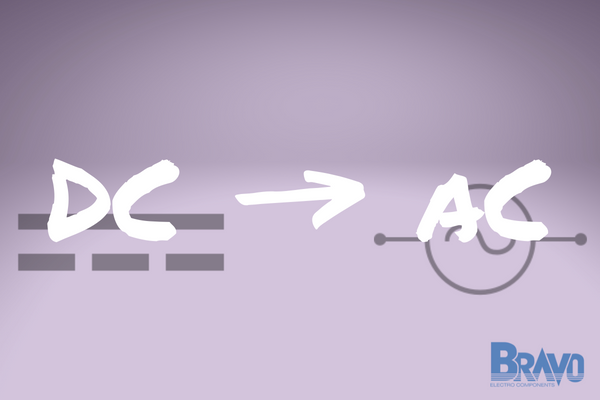
Whether you’re trying to power an air pump from your car while camping or you’re trying to use a backup generator at home while the power is off - learning how to convert DC to AC power supply is a great idea for anyone. Chances are, you’ll need to do it at some point in your life.
And fortunately for you, you’ve come to the right place. Because today, we’re going to teach you how to convert DC to AC power supply with ease using an inverter.
You’re also going to learn about a few different use cases for the inverter - in other words, situations where you may need to rely on a DC to AC conversion. But first things first - let’s go over a brief refresher regarding AC vs DC.
What’s The Difference Between AC vs DC Power?
No, it’s not just a band name - AC and DC are the two types of power supply in our world today. One was made famous by Thomas Edison (DC), and the other was made famous by Nikolai Tesla (AC). They both have their place, and there is still much debate today over which is superior.
In our blog post covering the difference between AC and DC power supplies, you’ll learn all there is to know about these two types. For now, we’ll just give you a brief introduction and overview of the two types for the sake of this article.
What is AC Power?
AC, or alternating current, provides power in an alternating current - it’s in the name. This means that power alternates between positive and negative, jumping back and forth along the wavelength.
The alternating nature of AC power allows it to be transmitted over long distances with minimal energy loss, making it the primary choice for residential, commercial, and industrial power grids.
One of the key advantages of AC power is it can be easily transformed to higher or lower voltages using transformers. This makes it ideal for distributing electricity across vast networks, ensuring efficient delivery from power plants to homes and businesses.
AC power is also inherently safer in some situations since it can be interrupted without sustaining an electric arc, unlike DC. It’s relied on to power household appliances, lighting systems, and office equipment.
What is DC Power?
DC, or direct current, is a type of electrical power where the flow of electric charge moves in a single, consistent direction. While AC oscillates, DC power is a stable and continuous flow of electricity. This is why it’s used in applications requiring precision and reliability.
It’s typically stored in batteries, capacitors, and other energy storage devices - in other words, it’ll be what you find in most portable electronic devices, electric vehicles, and other renewable energy systems such as solar panels.
DC power tends to be more efficient in low-voltage applications, so it’s relied on to power devices such as smartphones, laptops, and LED lighting.
While it doesn’t transport as efficiently as AC over long distances, it’s still preferred whenever reliability and stability outweigh the need for distance efficiency, such as in telecommunications systems and industrial machinery.
All things considered, we need both AC and DC power supply. But there are certain situations where you’ll be presented with a DC power supply and you need to convert it to AC power. Let’s take a look at some such examples before getting into how to convert DC to AC voltage.
Can DC Be Converted to AC Power?
Before getting into use cases for the DC to AC conversion or practical advice on how to convert DC to AC, let’s set your expectations. Can DC be converted to AC power in the first place? It sure can. In fact, this is essential in many applications.
DC to AC conversion requires electronically manipulating the steady flow of DC into an oscillating waveform, which mimics the alternating nature of AC. You’ll just need to find the right inverter for the job. More on that in a moment.
Why Would You Need To Convert DC To AC Power Supply?
At the onset of this article on how to convert DC to AC power, we discussed two specific instances in which you’ll need to convert DC power to AC power. Most household appliances run on the AC power supply built into your home.
That includes your refrigerator, for example. And say your home suffers a power outage - you’re worried about your food thawing and going bad. Can’t you just plug the generator in or use a 12v car battery? Not as things stand - because those external power supplies provide DC power. You need to first convert the power.
Another example is when you’re out camping - you want to blow up an air mattress or charge a phone battery. Unfortunately, your car’s battery won’t work as it is - again, it must be converted.
In industrial practices, one such case where you may need to convert DC to AC is in the medical field. Medical power supplies require an uninterruptible power supply as a backup in case the primary power supply fails. This backup UPS will require a DC to AC conversion most of the time.
There are plenty of other unique scenarios in which you need to learn how to convert DC to AC power supply - and for that, you’ll need an inverter. Here are some more examples before we walk you through how to change DC to AC:
- Solar Power Systems: These generate DC power to then be converted to AC for household appliances or grid integration.
- Electric Vehicle Charging Stations: Some EV chargers require DC to AC conversion for compatibility with on-board systems or to power other devices.
- Off-Grid Power Systems: Batteries in these setups create DC power, which must be converted to AC for standard appliance use.
- Portable Generators for Events: DC power from portable generators is often converted to AC for lighting or sound systems at outdoor events.
- Emergency Lighting Systems: Backup DC power in emergency lighting systems may need conversion to AC for infrastructure compatibility.
- Marine Applications: Boats convert DC power from batteries to AC for air conditioning, refrigerators, and onboard electronics.
- Telecommunication Equipment: DC backup systems in telecom towers sometimes convert to AC to power specific operational equipment.
- Industrial Automation and Robotics: DC power from emergency systems is converted to AC to keep industrial equipment running during outages.
- HVAC Systems in Remote Locations: Remote HVAC systems use DC sources like solar panels but require AC for compressors and fans.
- Railway and Transportation Systems: DC power from regenerative braking systems is converted to AC for auxiliary systems on trains and buses.
- Scientific Research Equipment: Research facilities convert DC backup power to AC for instruments designed to run on alternating current.
- Construction Sites With DC Generators: Construction sites convert DC generator power to AC for standard tools and machinery
There are plenty of use cases for the DC to AC conversion, so let’s not waste any more time. Here’s how to change DC to AC power.
How To Convert DC To AC Power Supply With An Inverter: Quick Guide to the DC to AC Conversion Process
So, how do you convert direct current to alternating current? Simple — with an inverter.
An inverter is a device designed to transform DC (direct current) into AC (alternating current) for compatibility with devices and systems that require alternating power.
While rectifiers perform the opposite conversion (AC to DC), inverters enable smooth transitions between power types so that DC sources like batteries or solar panels can power AC devices like refrigerators, lights, or industrial tools.
Let’s take a closer look at how inverters work so you can make the most of the DC to AC conversion process.
How An Inverter Works
While there are two types of inverters out there - mechanical and electronic - we will really only discuss electronic inverters, as these are the most common type of inverter in play today.
Modern inverters use electronic circuits to convert a steady DC input into an oscillating AC output. Here’s how the process works:
- DC Switching: Transistors in the inverter rapidly switch the DC input on and off, creating a pulsed current.
- Waveform Smoothing: Inductors and capacitors convert this pulsed signal into a smoother waveform, approximating a sine wave.
- Voltage Adjustment: A transformer adjusts the output voltage to match the requirements of the connected device.
- Waveform Types: Depending on the inverter, the output may be a pure sine wave (ideal for sensitive electronics) or a modified sine wave (suitable for basic devices).
Because the conversion process generates heat, inverters often include heat sinks or fans to maintain optimal performance. The size and weight of inverters depend on their power capacity, built-in batteries, and cooling mechanisms.
But in general, they tend to be larger than you might expect. This is important for the DC to AC conversion process as you need to make sure you can fit the inverter in your space. So, what size do you need?
What Size Inverter Do I Need?
You came here to learn how to convert DC power to AC power - and you now know that requires an inverter. You also know now that inverters take up space - so, how big of an inverter do you need?
Of course, this will depend on the voltage requirements of the specific device you’re hoping to power. Power supply sizing requirements for a small air pump will vary drastically from sizing requirements for your fridge. Our recommendation is to size up at least an additional 25% of your expected power requirements. Here are a few quick examples:
- Small Electronics: A 300W inverter works well for phone chargers or LED lights.
- Household Appliances: A refrigerator or microwave may require 1,000-2,000W.
- Industrial Tools: Larger inverters exceeding 3,000W may be necessary.
It is also worth noting that converting DC to AC power is a short-term fix - this approach is not long-term sustainable. If you still have questions about how to convert DC to AC, don’t hesitate to get in touch with our team here at Bravo Electro.
Final Thoughts On How To Change DC To AC Power Supply
That concludes our guide on how to convert DC power to AC power - all you need is a quality inverter. We recommend a true sine wave inverter rather than a square wave or modified sine wave. While you’ll end up paying more, you will enjoy greater efficiency, stability, and safety.
And, for all things AC DC power supply - look no further than our selection at Bravo Electro. We have everything you need and more - but most importantly, we have the expertise to help you get set up with exactly what you need. No need to play any guessing games - reach out and we’ll get you taken care of. Our on-staff electrical engineers are eager to assist you in making the most informed, accurate purchase! Here are some of the most popular power supply types we carry:
Find more tips on how to choose AC to DC converter or DC to DC converter in our blog. We have resources on power supply wattage, power supply efficiency, switching vs linear power supply, unregulated vs regulated power supply, isolated vs non isolated power supply, and more.
Otherwise, it’s time to find the perfect converter now that you know how to change DC to AC voltage. Get in touch with our team today or browse our catalog and find the perfect solution to convert DC to AC at Bravo Electro!

